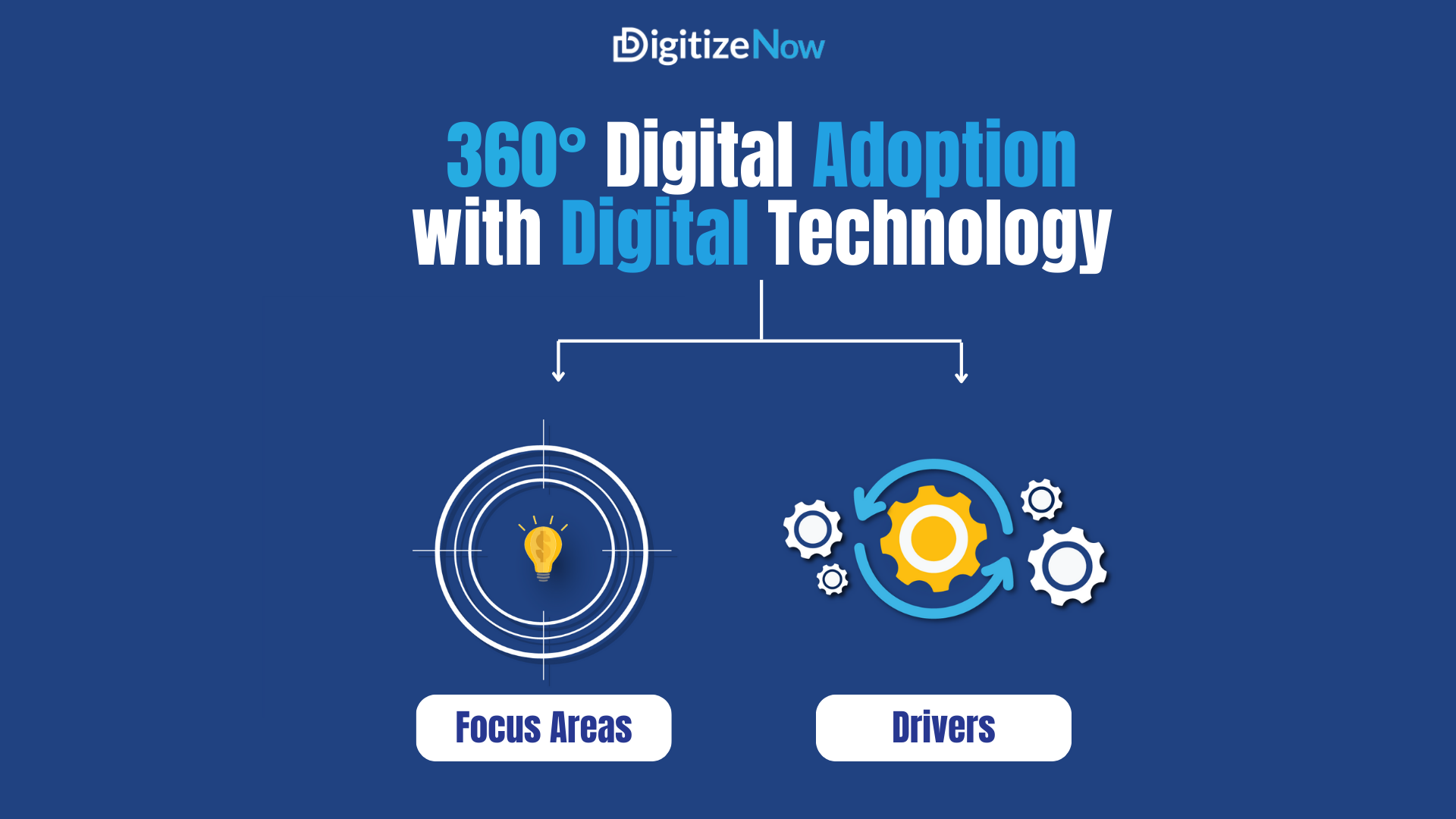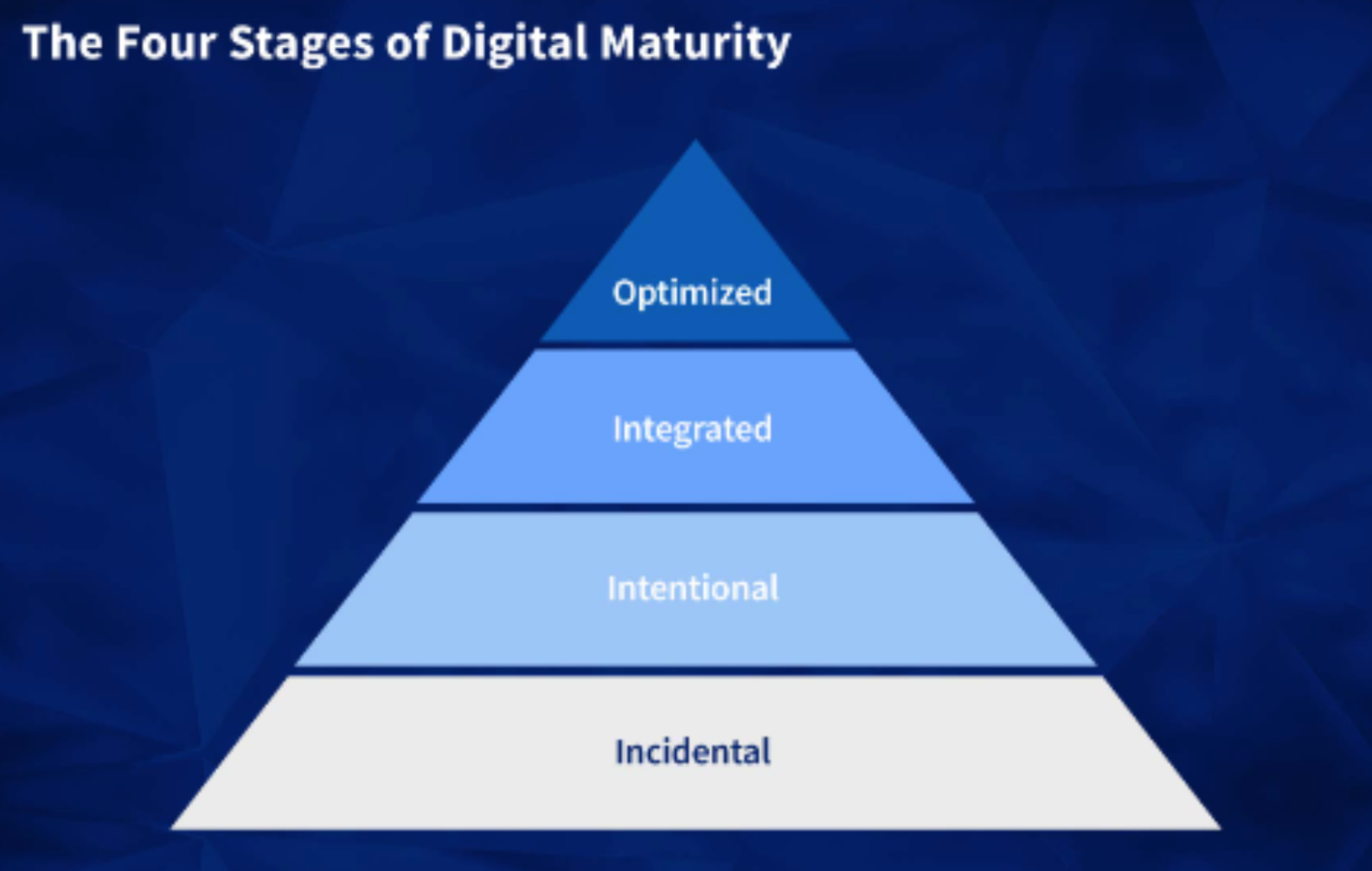In this age of digital technology, a company’s journey transcends mere technological integrations; it dives into the world of holistic progress through 360° digital adoption using digital technology.
Think about a business landscape where every facet, from user experience to data analytics, digital assets to transformation strategies, converges into a symphony of growth. In this blog, we will dive into the key focus areas and pivotal drivers that will bring such growth to a company through 360° digital adoption.
It’s not just about implementing technology; it’s about crafting that transformation journey that encompasses your organization’s user experience, data analytics, digital assets, and strategic digital transformation solutions.
When it comes to 360° digital adoption and implementation, digital technology in any organization or company leads to a holistic approach in the digital transformation journey.
The digital transformation will be beneficial for you irrespective of your field. Whether you’re a seasoned professional navigating digital technology in the modern landscape or an individual just stepping into this world, through upgrading and data analysis, you can make your business simpler by breaking down the complexities of digital adoption. It also explores the exciting terrain for growth and progress.
So, let’s move on and understand the key areas where technology meets transformation and how businesses can embrace this digital revolution.
Understanding Digital Technology
Digital technology is using digital systems, tools, and solutions to enhance and streamline various aspects of life and business.
Besides computers and smartphones, it encompasses a vast spectrum of technologies like artificial intelligence, cloud computing, and the Internet of Things (IoT), any technological platform that processes data. The scope is expansive, touching every part of our daily lives and transforming businesses’ operations.
Digital technology acts as a catalyst for organizational growth, enabling automation, efficiency, and innovation. Its impact is profound, from simplifying everyday tasks to fastening the business process.
Role of Digital Assets in Modern Businesses
Another critical aspect of digital technology is digital assets. Digital assets are not just files on a computer; they are the bloodlines of modern businesses. These assets include everything from your company’s website and social media profiles to data repositories and multimedia content.
Understanding the role of digital assets involves recognizing them as strategic components that contribute to a company’s identity, operations, and success. They are more than just pieces of information; they are valuable resources that, when managed effectively, can drive growth, enhance brand visibility, and create new opportunities.
Whether it’s optimizing their use for marketing, customer engagement, or internal processes, digital assets are integral to the digital transformation journey of any modern enterprise.

The key focus areas of a 360° digital adoption are:
The critical focus areas collectively form the comprehensive 360° digital adoption framework, guiding businesses towards holistic and successful digital transformation. Let’s go through them one by one:
Data Analytics in Business
Data analytics systematically analyzes raw data to extract meaningful insights, patterns, and trends. In 360° digital adoption, data analytics in business leverages results to gain actionable insights.
Data is used to make informed decisions, understand customer behavior, optimize processes, and predict future trends. It starts with collecting data and ends with transforming data into valuable information that guides strategic actions.
Through data analytics, businesses can measure performance, identify areas for improvement, and capitalize on opportunities. This includes everything from identifying customer preferences and tailoring customized marketing strategies based on those preferences. Data analytics also helps business organizations to have a competitive advantage by making a data-driven forecast.
User Experience Enhancement
User experience (UX) enhancement involves creating interactive and navigating digital platforms through digital technology. Prioritizing UX means ensuring that users have seamless, enjoyable, and efficient experiences when interacting with digital interfaces, whether websites, apps, or other platforms.
This goes beyond aesthetics; it involves understanding user behaviors, preferences, and pain points. Improving the user experience can increase customer satisfaction, loyalty, and even conversion rates.
Data-Driven Culture
Fostering a data-driven culture within the organization means instilling a mindset that values and utilizes data at all levels. It goes beyond data analysis; it’s about making data-driven decisions and creating knowledge from data.
In a digital technology and data-driven culture, employees are encouraged to base their decisions on data rather than intuition alone. This can involve providing training on data literacy, implementing tools that facilitate data access, and creating an environment where insights from data are not only welcomed but expected.

Digital Transformation Solutions
Digital transformation solutions encapsulate the strategies, technologies, and approaches that guide organizations through the continuous evolution and growth inherent in the digital transformation process. Adopting and integrating new technologies gives more competitive power to business organizations by optimizing processes and enhancing efficiency.
Navigating the digital transformation journey requires a tailored approach, considering the unique needs and goals of the organization/individuals. It may involve adopting cloud computing, implementing automation, or integrating artificial intelligence (AI).
The key is not just adopting technology for the sake of it but aligning solutions with the overarching transformation strategy to drive sustainable growth and success.
Digital Assets Management
For 360° digital adoption, digital assets encompass the legal and regulatory requirements of company data that suit today’s business needs. It includes everything from multimedia content, employee data, customer data, and documents to online platforms. It’s clear that effective management of digital assets is vital for leveraging them as tools for business growth.
Cybersecurity Measures
Cybersecurity measures are paramount to safeguarding digital assets and data. As businesses increasingly rely on digital platforms and technologies, ensuring robust cybersecurity becomes compulsory to protect against cyber threats, unauthorized access, and data breaches.
Implementing cybersecurity involves different types of security measures that protect data, networks, and platforms from cyber risk. This encompasses activities such as encryption, employee training on cybersecurity’s best practices, and deploying advanced security tools, among many other methods.
The goal is to create a strong and reliable digital environment that provides a secure foundation for digital technology operations that ensures digital assets, data integrity, and confidentiality.
In alignment with a McKinsey & Company report, businesses that prioritize data-driven approaches are shown to be 23 times more likely to attract new customers. This underscores the pivotal role of data analytics in customer acquisition.
The drivers propelling 360° digital adoption include
- Strong leadership with a clear vision drives 360° digital adoption. Leaders guide digital transformation with a clear vision, maximizing efficiency and fostering a unified approach. Leaders set strategic goals, secure resources, and create an environment for digital adoption. Their communication and inspiration are key to overcoming challenges and driving implementation.
- A digital-first culture is essential for seamless digital adoption. It integrates digital technology into every aspect of operations, decision-making, and collaboration, creating an environment where innovation and agility thrive. Organizations embracing a digital-first culture encourage employees to think digitally in their approaches and solutions.
- Upskilling and reskilling initiatives are essential for digital technology Investing in digital skills development ensures a workforce equipped to leverage digital technologies. Continuous learning programs empower employees to acquire skills for emerging technologies, enhancing individual and organizational capabilities.
- Businesses recognize that meeting and exceeding customer expectations in the digital era is a competitive advantage and a necessity for sustainable growth. Organizations adopt customer-centric digital strategies to enhance products, services, and interactions. This ensures relevance and competitiveness in the digital marketplace.
In wrapping up our exploration, 360° digital adoption is not merely a technological shift; it’s a profound organizational evolution fueled by a commitment to leveraging data analytics, optimizing digital assets, and prioritizing superior user experiences.
It’s clear that holistic development through digital adoption is more than a technological evolution—it’s a strategic embrace of data analytics in business processes, fostering a data-driven culture, and creating seamless user experiences.
The challenges and opportunities emerging technologies present require a steadfast commitment to innovation and a readiness to embrace the ever-evolving landscape of digital transformation.
360° Digital Adoption is not just a destination; it’s an ongoing voyage toward growth, resilience, and relevance in an increasingly digital technology-facilitated world.



